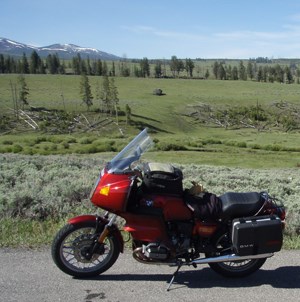In many units of the National Park Service, motorcycles are used as an effective means of transportation, bringing visitors to and from a park destination while using less gas than most automobiles. Motorcycles may also be used for touring within a park. Done safely, responsibly, and respectfully, riding a motorcycle through a national park can be a wonderful way to experience our nation's natural and cultural heritage. However, it is important to be aware that excessive noise from motorcycles can have significant impacts on wildlife and other park visitors. If riding a motorcycle is part of your planned visit, please ride safely and help protect the parks by following these simple tips.

Photo by Bill Nelson
Ride Respectfully
- Obey speed limits.
- Avoid traveling in large groups.
- Avoid excessive acceleration or revving of the engine.
- Turn your engine off instead of idling.
- Use horns only when necessary for safety.
- Turn down radios or use a headset.
- Be extra sensitive near campgrounds, lodging, and visitor centers.
- Operate your motorcycle as quietly as possible to minimize disturbance to wildlife and other park resources and respect the experience of other visitors.
Natural Sounds in National Parks
Park soundscapes are part of a web of natural and cultural resources protected by the National Park Service (NPS). The acoustic environment is a resource that NPS protects, just like air or water. Parks are actively working to minimize noise pollution from many sources, both internal and external. Noise can adversely impact wildlife by reducing the area over which they can communicate and listen for potential prey or predators. Natural sounds are also important to park visitors, 90 percent of whom say enjoying the sounds of nature is one of the top reasons they visit parks.

Photo courtesy of J. Ellison
Why Motorcycles?
The NPS is concerned about the effects of noise in general on wildlife, visitors, the acoustic environment, and other park resources.Over the past ten years, complaints from visitors concerning excessive noise from motorcycles have been increasing. The tips above apply to all vehicles in national parks; however, low-frequency sound, like that from some motorcycles, travels farther than noise from other vehicles with higher frequencies. Additionally, some motorcyclists choose to use modified pipes, which have the effect of increasing noise. As a result, these motorcycles can often be heard far into the backcountry. In order to encourage responsible use of motorcycles on park roads, the NPS has begun an outreach campaign to remind motorcyclists of the importance of riding respectfully in national parks.
To help protect park resources and visitor enjoyment, the NPS supports the American Motorcyclist Association's (AMA) official position on excessive motorcycle noise:
"The AMA believes that few other factors contribute more to misunderstanding and prejudice against the motorcycling community than excessively loud motorcycles. All motorcycles are manufactured to meet federally mandated sound control standards. Unfortunately, a small number of riders who install unmuffled aftermarket exhaust systems perpetuate a public myth that all motorcycles are loud."
Learn about the noise traffic display signs that the NPS installs in parks to encourage slower (and quieter) driving.
Last updated: November 6, 2017
